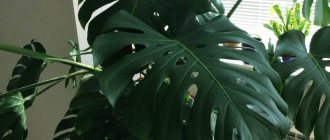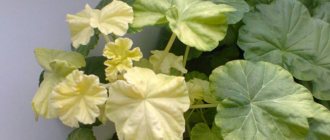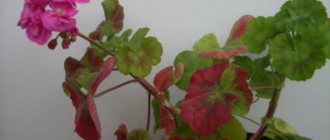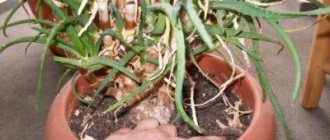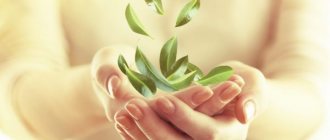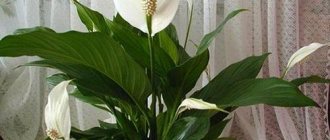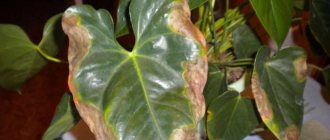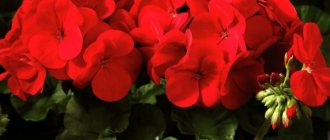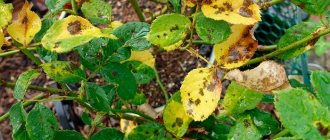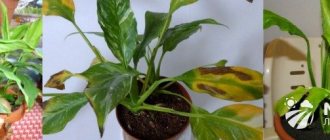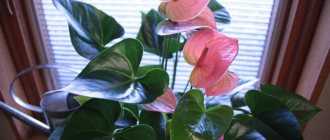How to revive a plant in advanced cases
It happens that the problem was identified untimely due to the departure or busyness of the owner.
You can save an anthurium even if it has no leaves at all. When performing work, remember that the plant is poisonous, its juice contains toxic compounds and can be absorbed into human skin and leave burns on it. The plant itself belongs to the group of epiphytes; its reproduction is ensured by aerial roots. If the anthurium has dropped all its leaves, it should be removed from the pot. This is necessary to inspect the root system for rot, infections and pests.
@ Martina stock.adobe.com The appearance of yellow spots along the edge of the leaf may indicate overwatering of the root system or insufficient air humidity
It is mandatory to treat the plant using chemicals. If there are dormant buds (green tubercles) on the surface of the trunk, there is a chance of salvation.
Do not forget about the following point: the root system of anthurium is fragile, so the grower must be careful when working with it. Roots that are white or yellow and firm to the touch are considered alive.
Black and soft - rotten, they do not take part in the process of providing the aboveground part with nutrients. In addition, they are considered a source of infection; their decomposition process can spread to the stem and leaves.
Plant resuscitation is ensured according to the following algorithm:
- The first thing to do is to stimulate the development of aerial roots. They actively grow and develop in a warm and humid environment. If the stem has no roots at all, it should be wrapped in sphagnum and placed in a humid environment, such as an improvised greenhouse. Full roots will sprout in 2-3 weeks.
- The resulting sprout can be rooted in a small pot, but for the above-ground part it is necessary to arrange a greenhouse. The appearance of new leaves indicates that the plant has taken root.
@ Molly stock.adobe.com Anthurium Pink Flamingo
Before re-rooting, you need to make sure that the roots of the plant are really damaged. To do this, a simple experiment is carried out: the roots are soaked in warm water and cleaned of the remaining substrate. Living elements after this process will be noticeable; they have a white or slightly creamy color and a dense structure.
Preventive measures
Why do hydrangea leaves dry around the edges - what to do and how to revive the flowers
Prevention of blackening of anthurium consists of proper care and provision of favorable conditions for its life.
Useful tips for proper care
In order for anthurium bushes to bloom all year round, and for the flowers to be beautiful and bright, it is necessary to care for it correctly and in a timely manner. Basic recommendations:
- Choosing a room. In the room, the anthurium should be placed on a southeast or west window so that the flower can receive enough sunlight. This will prevent the plant from getting burned due to direct light at midday. In winter, the flower should be placed away from equipment for heating the room. If it is impossible to move the plant to another part of the house, place a tray of water next to the pot. As it evaporates, the air humidity will increase.
- Selecting soil and container for planting. Rhizomes can suffocate due to lack of oxygen. To avoid this, you need to use a soil mixture that allows air to pass through. River sand and oak bark, as well as crushed peat, are added to it. It is better to take a plastic pot.
- Humidity. To provide comfortable conditions for anthurium, you need to create a tropical climate for it. To do this, the leaves of the flower are sprayed with water daily and checked to see if it is dripping onto the surface of the inflorescences. In addition, experts recommend regularly placing the flower pot in a pan of water for a few minutes.
- Watering. In hot summers, it is recommended to add nutrients to the soil along with water. This should be done no more than 2-3 times a week. In winter, the frequency of watering is reduced to once a week. It is better to irrigate the plant using a watering can or sprayer. After watering, it is recommended to wait until some of the water is absorbed and remove the rest.
Placing a flower indoors
To determine the cause of blackening of anthurium leaves, you need to constantly monitor the plant. It is better to eliminate identified problems at an early stage of the appearance of spots than to pull out and throw away infected bushes.
Why do anthurium leaves turn yellow after transplantation?
Often gardeners are faced with the problem of yellowing leaves of anthurium after transplanting it. It should be noted that this procedure is a kind of stress for the plant, the consequences of which can negatively affect the condition of the flower.
The reasons that the leaves darken and turn yellow after transplantation may be:
Untimely flower transplantation. A young plant up to 4 years old needs to be replanted annually into a new container with a new substrate. It is recommended to plant adult perennials in a new pot every 2–3 years. At the same time, it is recommended to carry out activities for transplanting exotic plants in early spring - from February to May.
Pot size. It is necessary to choose a container that is 2–3 cm larger in diameter than the previous one, with large drainage holes required to remove excess moisture.
The soil. For an epiphyte, the optimal soil composition is a mixture of humus, leaf soil, peat and river sand, mixed in proportions 2: 2: 1: 0.5
It is very important that the soil is as breathable as possible, light and loose. Hard, heavy, airtight soil will cause foliage to yellow and dry out.
Feeding
Experts advise carrying out the first feeding after transplanting a perennial no earlier than one month. During this time, the plant will have time to adapt to new conditions and begin to actively develop.
It is worth noting that yellowing of the leaf blades after replanting can be caused by the use of low-quality water for irrigation. Water with impurities of heavy metals or chlorine is harmful to the flower.
Useful tips for proper care
Hydrangea diseases - leaves turn yellow or black, dry out
When growing a flower, the following points should be taken into account:
- monitor the air humidity in the room. You can increase it with an air humidifier, placing vessels with water next to the flowers, spraying the leaves with a spray bottle;
- place the plant away from direct sunlight;
- water the anthurium when the top layer of soil is slightly dry, and using only settled water at room temperature, immediately drain the excess from the pan;
- when planting, provide a good drainage layer that will protect the roots from excess water;
- place the plant where it will not be exposed to cold air and drafts;
- Feed the plants regularly, monitoring the amount of feeding.
It is possible to save your favorite home anthurium from diseases. The sooner treatment begins, the greater the chance of maintaining it. But, of course, it is better to prevent damage to the leaves and buds by providing them with proper care and the necessary conditions.
Why do the leaves of the “male happiness” flower become covered with brown spots?
Most often, brown spots appear on anthurium leaves due to non-compliance with care rules. If you study all the individual characteristics and “whims” of the plant, you can easily achieve maximum decorativeness of the look.
Anthurium houseplant
There are several reasons why anthurium leaves may turn brown:
- Improperly organized watering of the plant.
- Untimely application of fertilizers to the soil.
- Very dry air in the room where “male happiness” grows.
- Failure to comply with the length of daylight hours.
- Sharp cold snap.
Failure to follow the rules of care can lead to rotting of the roots and the rapid spread of fungus. The plant may also become covered with spots due to attack by pests.
Change leaf color
Overflow
For this species, it is extremely important to comply with watering standards. Excess moisture, as well as deficiency, will certainly lead to anthurium diseases
Frequent and irregular watering will lead to rotting of the roots.
Brown spots may appear on the leaves if liquid gets on the plate itself. If you do not respond to the problem in a timely manner, this can lead to the death of the entire green part of the plant.
Popular articles Black truffle: description of the mushroom, value, market value
On a note! High humidity is a favorable environment for the development of mold and fungal infections.
Watering with cold water
The use of cold running water is detrimental to anthurium. The chlorine it contains instantly damages the roots.
It is recommended to water the flower with warm water, standing for 2 days.
Unsuitable soil
Thanks to high-quality soil, the plant is nourished. Anthurium loves nutritious soil. It is very easy to prepare it yourself. To do this, you need to mix the ingredients in the following proportions (2:1:1:0.5):
- humus;
- leaf soil;
- peat substrate;
- river sand.
Important! It is imperative to lay a thick layer of drainage material at the bottom of the pot.
Low room temperature
A low temperature can cause harm only if the anthurium is left in such a room for a long time. Short-term changes do not pose any danger.
Failure to comply with the temperature regime leads to damage and rotting of the roots. The leaves turn yellow and dry out completely. The flower stops developing and dies. For salvation, it is necessary to create the right conditions and carry out the necessary treatment.
Attention! Yellowing of the leaves can occur for natural reasons - due to the age of the flower. If the lower ones turn yellow and fall off, then you should not worry.
After a short period of time, new ones will grow.
Root damage
During replanting, unintentional damage to the root system may occur. Because of this, black spots appear on the flower.
The event must be carried out as carefully as possible - using the transshipment method
Even if the root shoots were accidentally broken or damaged, they must be treated with manganese and sprinkled with charcoal before being lowered into the ground.
Sunburn
A change in foliage color may indicate that you have chosen the wrong location for the anthurium. Placing the plant on a south-facing windowsill can lead to sunburn. Their appearance is characterized by yellowing and curling of the foliage.
To save the flower, it must be moved to a shaded area of the house.
Septoria infection
This disease develops as a result of damage by a fungus. If treatment measures are not taken, the spots will grow quite quickly. With a prolonged disease, the leaves turn completely black.
Septoria lesion
This infection must be treated urgently. To do this, treatment is carried out with Fitosporin or 1% Bordeaux mixture.
Attention! All damaged areas must be completely destroyed
Aphid attack
Parasitic aphids live on leaves and suck the juice from them. Therefore, the leaf plates curl and become sticky. Without proper treatment, the flower quickly dies.
To treat the anthurium, it is necessary to wash it with soapy water and then pour it with manganese or Fitosporin.
Aphid invasion
Scale insect attack
What to do if brown spots appear on the leaves of anthurium due to an attack by scale insects? The first signs of an attack by these particular insects are pronounced white or yellow tubercles.
Most often they appear on the leaves, and only then cover all the green parts of the flower. The scale insect feeds on the sap of the plant and because of this, the leaves begin to dry out and tear. For treatment, it is recommended to use any fungicidal preparations.
External signs of scale insect damage
What to do to save a flower
Saving a plant should begin with proper care of it, and then carry out those procedures that correspond to the type of disease.
Anthurium - home care: why leaves dry
In the case of a fungal disease or infection with bacteria or viruses, self-salvation is unlikely. Therefore, first of all, they get rid of all the leaf blades that are burned so that the infection does not spread to other house flowers.
The appearance of a gray coating on flowers, leaves, as well as redness of the lines and tips indicates a disease with gray mold. Young and newly transplanted anthuriums are more often infected. This is mainly a consequence of excessive watering, poor drainage, ignoring the removal of dry and dead parts of the plant, and neglecting to ventilate the room.
When septoria disease develops, it is necessary to spray the leaves with a chemical fungicide that contains a large amount of copper. If rust develops, it is worth spraying the bush more often, increasing the humidity in the room, and the affected greenery is cut off and burned.
To cure anthracnose, it is necessary to reduce watering and spray with copper fungicides. You can also add the chemical preparation Abiga-Pik to the soil substrate.
Note! If the flower does not respond to treatment, then it is burned so as not to infect other indoor plants in the house.
To eliminate Fusarium wilt, you will have to treat the plant with copper insecticides and spray the soil substrate with gliocladin. It is best to get rid of all the soil; before replanting, place the plant briefly in a weak solution of potassium permanganate and plant it in fresh soil. The soil is disinfected.
Shchitovka
If a scale insect is detected, it is necessary to immediately carry out mechanical cleaning and apply insecticidal preparations. These agents are also used when fighting thrips.
Having discovered a spider mite at an early stage, you can give the flower a warm shower. If there are a lot of insects, then special preparations are used against this parasite. Treatment for this parasite will take a long time. Be sure to remove cobwebs and wipe the pot and window sill.
Important! The difficulty is that the remaining larvae live for a long time and can appear again even after a year. Therefore, it is necessary to periodically treat the affected plant and those specimens located next to it with soapy water.
Main diseases, causes of their occurrence and methods of control
Plant problems become noticeable by changes in color, deformation of leaf blades and petioles. The appearance of spots, plaque, drying out, wilting, and loss of luster in the aerial part is possible. Cultural diseases are varied and arise for various reasons. In most cases, the provoking factor is a violation of the indoor flower maintenance regime.
Having noticed the first signs of ill health, you should immediately take measures so as not to lose the plant. Damage to the root system can begin much earlier than more noticeable symptoms appear.
Anthurium diseases occur for several reasons:
- violation of agricultural cultivation techniques;
- fungal, bacterial infections;
- pest settlement.
Non-infectious
This group of diseases is provoked by improper living conditions or inadequate care. Anthurium prefers to grow in an environment of high humidity, warmth, and sufficient, but diffused lighting. Excess water reaching the rhizome often causes rotting.
Diseases in which anthurium leaves dry out occur due to insufficient watering or low ambient temperature:
- Chlorosis manifests itself when using hard chlorinated water when moistening the soil and above-ground parts, violating the feeding regime, and exposure to drafts. Characteristic symptoms arise due to the lack of a drainage layer in the flower pot, leaving liquid released after watering in the pan.
- Exposure to direct sunlight causes burns to anthurium leaf blades. Almost all representatives of the species require good and long-term lighting, but cannot tolerate the sun. The resulting dry patches cannot be treated.
- Hypothermia, high humidity, low temperature provoke the development of plant pox.
- Sudden changes in thermometer readings, drafts, and excess moisture in the air followed by drought lead to enation. This disease causes curvature, deformities, humps on the leaves, and their uneven growth.
Non-infectious lesions can be cured by creating optimal growing conditions for anthurium. In addition to the microclimate, timely, complete care required by a specific crop variety during a certain growing season should be provided. It is permissible to use various growth stimulants to accelerate the recovery of damaged tissue. Ignoring the symptoms will lead to the loss of decorative value of the indoor flower, the appearance of diseases and pests due to reduced immunity.
Infectious
The provoking factor for most diseases is an unfavorable environment. Anthurium is often affected by fungi, bacteria, viruses when kept in conditions of low or high temperature, excessive moisture, lack of nutrition and light. Strongly weakens the indoor plant's exposure to drafts.
The most common infectious flower diseases:
- gray mold;
- anthracnose;
- fusarium;
- septoria;
- root and stem rots;
- sooty mushrooms;
- rust;
- powdery mildew.
Anthracnose
The fungal disease is typical for crops grown in open ground, but when certain conditions are created at home, it also affects plants. A comfortable environment for anthracnose is a temperature of +23...+27 °C and air humidity close to 100%. With the disease, brown dry spots appear, covered with black dots. The affected leaf becomes colorless, wrinkles, and falls off. In this case, infection of the anthurium root system is possible.
Prevention and treatment of diseases
As a rule, compliance with cultivation technology and provision of adequate care for the plant practically does not affect spathiphyllum diseases and pests. However, special attention should be paid to indoor flowers in the following cases:
- a common pest of Spathiphyllum is the mealy bug, which destroys the leaves, which need to be rubbed with a weak alcohol solution and then sprayed with an infusion based on citrus peels or “Actellic”;
- infection with black fungus is accompanied by blackening of spathiphyllum leaves, and for treatment, treated surfaces are used with a standard soap solution;
- Significant damage to the flower can be caused by shield moth, which provokes the appearance of dark spots on the house plant, as well as by using soap and tobacco solution or treating the air part with nicotine sulfate, in the amount of 1 g of the drug per 1 liter of warm water.
The best way to prevent damage to Spathiphyllum from pests or diseases is to systematically wipe the leaves with a damp sponge.
Signs of dry and wet blackening of spathiphyllum leaves
Darkening of foliage is the process of black or brown spots appearing on its surface. Subsequently, they become deformed and dry out. At first, the leaf blade may turn yellow. Then it acquires a dark shade, turns black, and dies.
Spathiphyllum is a beautiful ornamental plant
The leaf may be covered with dark spots evenly or randomly. If measures are not taken in time and the bush is not treated, the leaves completely turn black and die. Moreover, at the very beginning of this process, all the decorativeness of “female happiness” is lost.
If spathiphyllum leaves turn black, this indicates a violation of the rules for caring for the crop. Externally, this symptom may look different:
- The ends of spathiphyllum leaves dry out and darken. This creates a large brown area around the edges. After some time, these fragments dry out and become more fragile. Affected leaves die and fall off. If they do not fall off, the bush still becomes less decorative. In this case we are talking about dry blackness.
- There is also a flaccid or weeping darkening. At the same time, the black leaves acquire a wet consistency and become softer and slippery. They lose their density. This phenomenon often becomes very extensive and widespread. Spores, mold, and fungi often form on the affected area.
It is worth considering that the ends of the leaves or the entire blade of the plant may darken. Also, the roots and flowers of the plant sometimes turn black. Depending on the provoking factor, the affected fragments grow rapidly.
If not properly cared for, spathiphyllum leaves turn black.
Why do the tips of leaves dry out?
If the leaf edge dries out and becomes thinner at the edges, it is most likely anthracnose, also a fungus that needs to be treated with appropriate medications. When the tips of the leaves dry out and then curl up, this is a greenhouse aphid, which can only be controlled by using insecticides - Actellik or the well-known Karbofos.
In the absence of diseases, if only dry foliage is observed, the container with the flower is removed to a safe distance from the heating. Daily spraying should be included in the flower’s diet, regardless of the season.
If the problem is, nevertheless, anthracnose, the anthurium is urgently transplanted into new soil, to which charcoal, pieces of red brick and small parts of forest cones are added. Adding large particles of natural substances will help make the soil loose, as a result of which the flow of oxygen to the roots will increase.

